Restless legs: Behind the scenes with the Capitals on a back-to-back swing

This story appeared in the Jan. 25, 2016 issue of SPORTS ILLUSTRATED. To subscribe, click here.
On the darkened tarmac at the empty airport, carrying their per diems and their passports, the Capitals hustled aboard Delta flight 8951, chartered service from Dulles International to Toronto Pearson. A construction trailer doubled as a security checkpoint, where all 22 players, six coaches, three equipment managers, two trainers, a massage therapist, one general manager, one hockey operations analyst and one director of team services were verified on the manifest. A conveyer belt fed 2,770 pounds of equipment into the plane’s belly. Aboard the Boeing 737 flight attendants prepared meals of strip steak and salmon salad. The team chef went heavy on protein for a reason. After Washington beat Tampa Bay 4–2 at home on Nov. 27, only 21 hours and 18 minutes separated the Caps from a meeting with the Maple Leafs across the border. They needed to refuel. Fast.
A voice crackled over the speakers. Stand by for all‑call.
From his standard window seat in the second row, head coach Barry Trotz checked his watch. It was 9:42 p.m., an unusually early departure time for a back-to-back, but after a 5 p.m. start against the Lightning, his team gladly welcomed the extra hours of cushion. Besides, this post-Thanksgiving twin bill already seemed like a logistical cinch. The drive to the airport had never been faster. The forecast predicted no bad weather. The itinerary showed a midnight arrival at the Ritz-Carlton on Wellington Street West, one of the poshest hotels in the league. “This is the miracle trip,” Trotz said, picking at his salmon salad. He also knew not to be fooled into complacency. This was the fifth of the Capitals’ 13 back-to-backs this season. The whole traveling party understood how chaotic these swings could be.
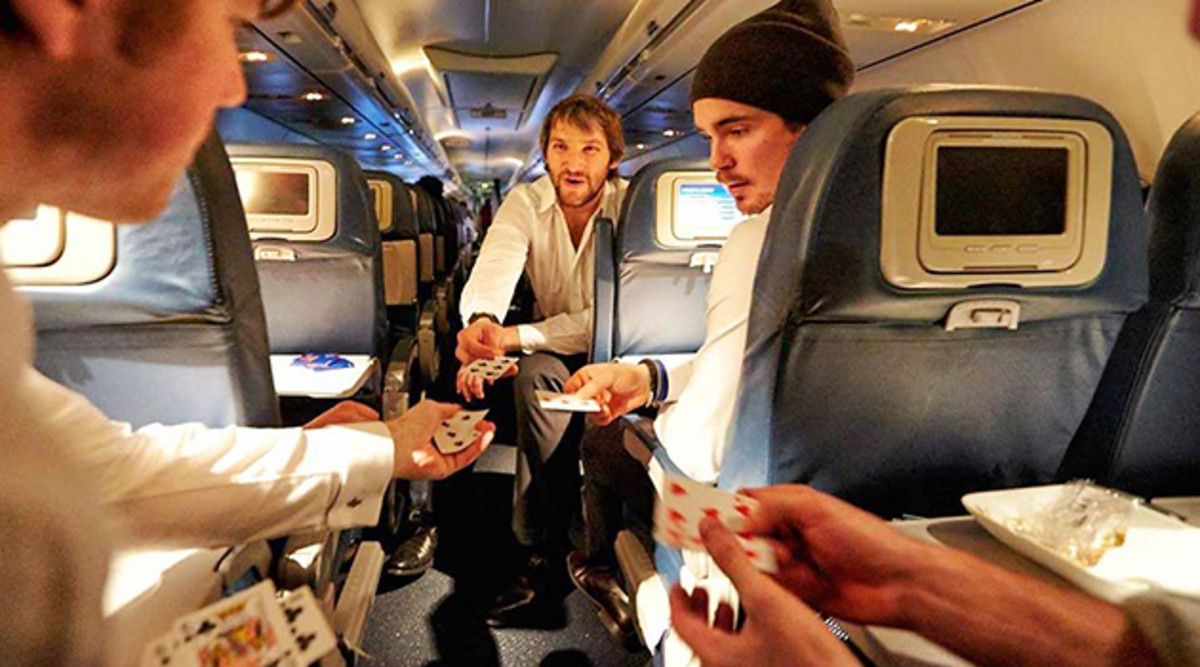
An hour earlier, as the players left the ice at the Verizon Center, the home locker room had turned into a jungle. Only when a road game beckoned the next day would postgame at home be so hurried. Equipment bags were wheeled out the back exit and stuffed into a box truck. Down the hall the coaches rushed through a postgame film-review session before heading to the airport. Players scrambled to shower and kiss their loved ones goodbye, scarfing down food and knotting their ties on the walk to the garage. And now they were here, climbing to 20,000 feet.
Hockey Night in Canada towel is the must-have for players
To guard against fatigue, the trainers distributed dissolvable tablets of magnesium, which can improve brain function, and packs of powdered Pedialyte to replenish electrolytes. In first class, assistant coach Blaine Forsythe worked on the even-strength report he would deliver to the team the next morning. “People just see us play the game here Friday, then they see us on TV Saturday night,” Forsythe says. “They don’t understand the hours of prep that go into it.” Near the back of the plane forward T.J. Oshie switched on an electric stimulation device, an Accelerated Recovery Performance (ARP) machine, and relaxed while playing cards. Across the aisle Brooks Laich downloaded his shifts against Tampa Bay from the team’s external hard drive and began watching as the cabin lights dimmed.
This season NHL teams will play a combined 412 back-to-back sets—two games, held on consecutive days. All but 25 of these schedule land mines will require travel between games: road-road, road-home or, as with this late-November grind for which the Capitals gave SI exclusive, behind-the-scenes access, home-road. Across such a long season the regular rhythm of NHL life invariably meets disruptions. Aching muscles. Swelling bruises. Engine malfunctions. Blown tires. Stiff mattresses. Or, as the Capitals found last February while snoozing between an otherwise stress-free afternoon-afternoon swing, a screeching hotel fire alarm in downtown Philadelphia. On an ordinary trip these issues can be easily shrugged aside, but back-to-backs offer no buffer.
Yes, NBA teams average more back-to-backs (17.8 per team, compared with 13.7 in the NHL this season) while also squeezing 82 games into six months, and MLB teams play almost eight games for every one day off. But factor in the bruising demands of hockey, a league footprint that stretches from Vancouver to south Florida and the frequency with which things like border customs and snowstorms can present delays, it can be reasonably argued that NHL back-to-backs are the toughest of any sport. “It almost seems like a continuation of the game before,” Laich says. “From the third period almost to playing a fourth, fifth and sixth period. You stay in game mode, and they roll one into the other.”
After a smooth 47-minute ride, the plane dipped below the clouds and onto the runway. Two buses carried the team to its hotel in downtown Toronto. Left behind were six men dressed in polo shirts with Capitals logos, staring into the glow of the cargo hold, their night nowhere near over.
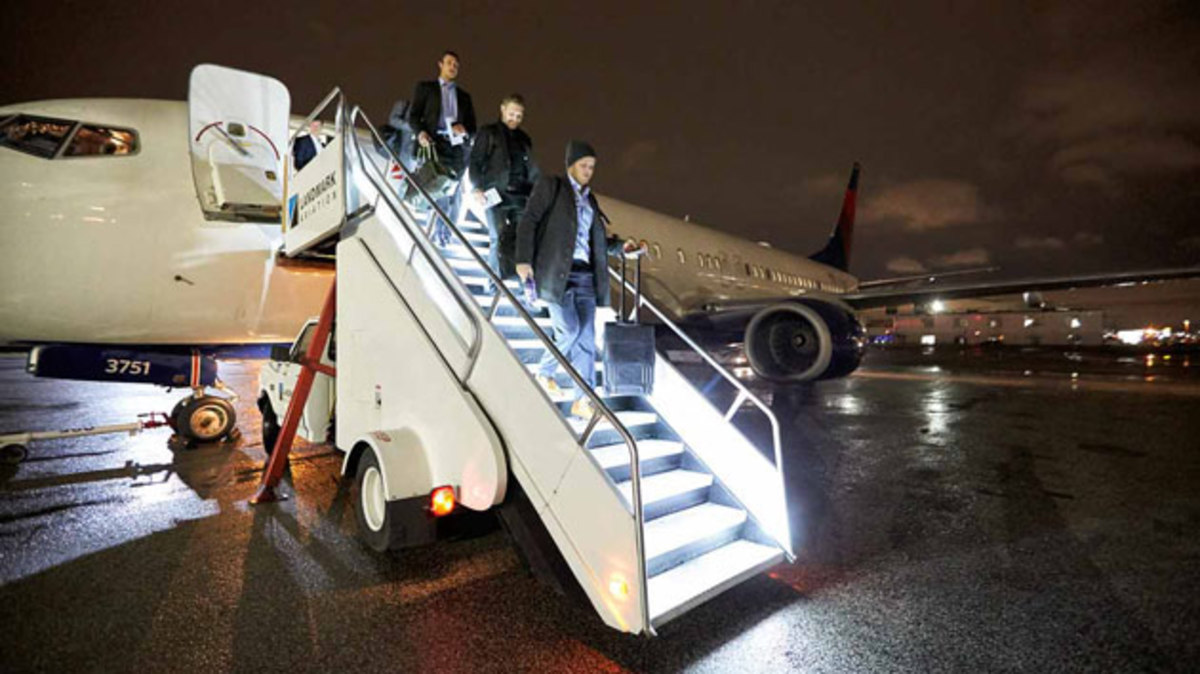
The Capitalschecked into their rooms and settled into their plush beds, but a few blocks away the hallways of the Air Canada Centre were humming. Trunks flew from the loading dock into the visiting locker room, a reverse of the process that had occurred at the Verizon Center four hours earlier. The clock above the door read 11:25 p.m. Among the six Capitals support staffers working this late, only the three equipment managers were fulfilling their actual job descriptions. The others, two athletic trainers and a massage therapist, assisted for reasons head trainer Greg Smith explained like this: “We’re the team within the team.”
The quicker they worked, the sooner they slept, so no one turned down jobs. Smith lined up shower sandals in the coaches’ room. One door over the massage therapist, Robert Brown, hung laundry bags for the players in the dressing room. In the entryway, assistant trainer Ben Reisz arranged sticks in numerical order—there were 113 on the rack, plus a 114th, used exclusively as a guideline for star winger Alex Ovechkin’s sticks and labeled “MEASURE STICK DON’T TOUCH MOTHER-------!” Each stall was organized just like the next: Helmets on the top shelf, jersey hooks angled to the left, numbers facing out. Every detail felt important. The less the players’ routines were interrupted, the more they could focus on hockey.
Like Trotz, the support staffers loved the Miracle Trip for its early start. It sure beat the home-road swing to Florida on Halloween, during which they finally fell asleep around 5:30 a.m. Or the time they waited in the truck for Rascal Flatts to finish their set. Or when they were stopped from unloading at Madison Square Garden because the circus was in town. In 2001 the Capitals’ crew encountered a thick-chested- bouncer blocking the entrance to the locker room at the Air Canada Centre, refusing to budge during a Britney Spears show. Some back and forth ensued until, from around the corner emerged Spears’s then boyfriend. Noticing the logos on the gear, Justin Timberlake told the bouncer, “These guys are all right.”
Alternatively, as one team official put it, they are “the heroes on the road.” It is for this reason that four players wrote three-digit numbers on the whiteboard before warmups against Toronto, then tipped the equipment managers that amount after the Capitals won 4–2. It was a gesture of thanks to those who finally left the ACC a minute shy of 1 a.m.
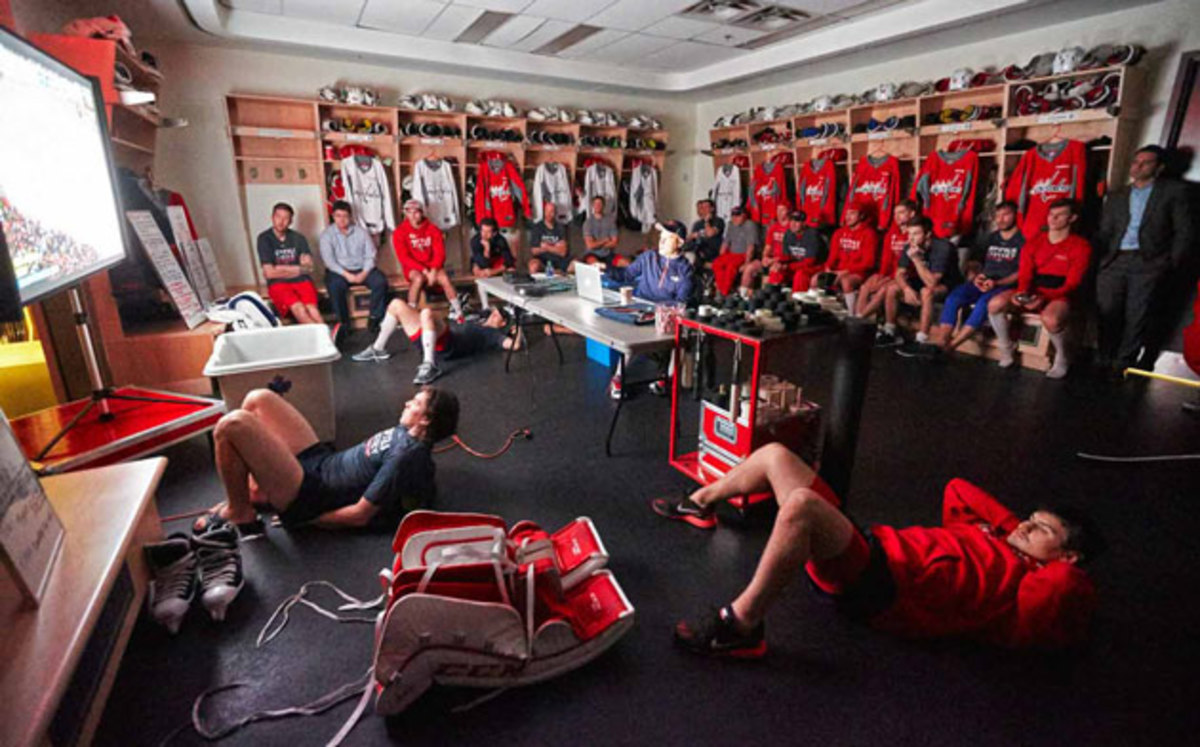
The next morning, as the sun rose over the CN Tower and the players awoke at the hotel, Trotz and his staff walked to the rink for their morning meeting. Taking their seats inside the windowless coaches’ room, they opened their MacBooks and pecked away at their scouting assignments, each breaking down a different aspect of the Leafs. A portable printer spit out reports on face‑offs and scoring chances. The television displayed the Capitals’ video software program, a dizzying cluster of clips—largely from Toronto’s three most recent games—each tagged with any combination of 61 possible labels, like forecheck and fight! From the database they built a presentation to bring a game plan to life.
Even more than physical wear and tear, Trotz believes mental burnout poses the biggest threat to players during back-to-backs, so his assistants are constantly mindful of the line between sufficient preparation and information overload. Back-to-backs can test coaches this way. At once, the tight schedule narrows the window of preparation and places greater importance on what they do share. “You don’t want them leaving the meeting going, ‘Jesus, I don’t even know what to think about,’” Forsythe says. As winger Jay Beagle adds, “There’s such a thing as too much.”
Ranking the NHL’s best, worst general manager-coach combinations
To avoid this pitfall, the coaches organized the footage in the same manner as always—face‑offs first, offensive zone last—so the players knew what was coming next. They featured segments that showed the Capitals executing well, to promote confidence, and pared it all down to two clips per topic. “One of what [the opponents] do, one of how we beat it,” Forsythe says. Two hours before the players arrive, the staff reviewed the presentation together. They included a clip of Toronto’s quick transition game and one of Ovechkin’s smart read on a power-play breakout. Throughout the day assistants grabbed players for brief, two-minute refresher courses—anything to interrupt the monotony of long meetings about systems.
“It’s a different way of learning, a different way of teaching,” Forsythe says. “But it’s also a way to get your information across without boring them to death with the same bull‑‑‑‑.”
Another way? Bringing a former special operations agent to address the team about mental strength and overcoming fatigue, as Trotz did before the regular season began. Last season Washington struggled with slow starts in the second game of back-to-backs, often falling behind early and going 7-8-1 overall. “This is an area I want to see improved,” Trotz told him.
“S‑‑‑ happens,” Trotz says, “How do you deal with the s‑‑‑?”
With a 6‑1‑1 record in back ends this season, the Caps have gotten better. And with the best record in hockey, 35-8-5 as of the All-Star break, they see no reason to change their approach. Six whiteboards packed with notes on Toronto’s power play, penalty kill and even-strength systems awaited Washington’s players upon their arrival. A projector screen glowed with the team motto, stick to the script. As everyone squeezed into their stalls, the penalty-kill presentation, led by assistant Lane Lambert, began at 10:45, followed by Forsythe’s five-on-five talk at 10:52. Showing the footage the coaches had just dissected, he zipped through 42 clips in 10 minutes.
When Forsythe finished, Trotz stood up. “We talk about back-to-backs, we talk about mental toughness,” he told the players. “You’ve got to make sure your minds are right, your bodies are right to play a fast, f‑‑‑‑‑‑ hard game.”
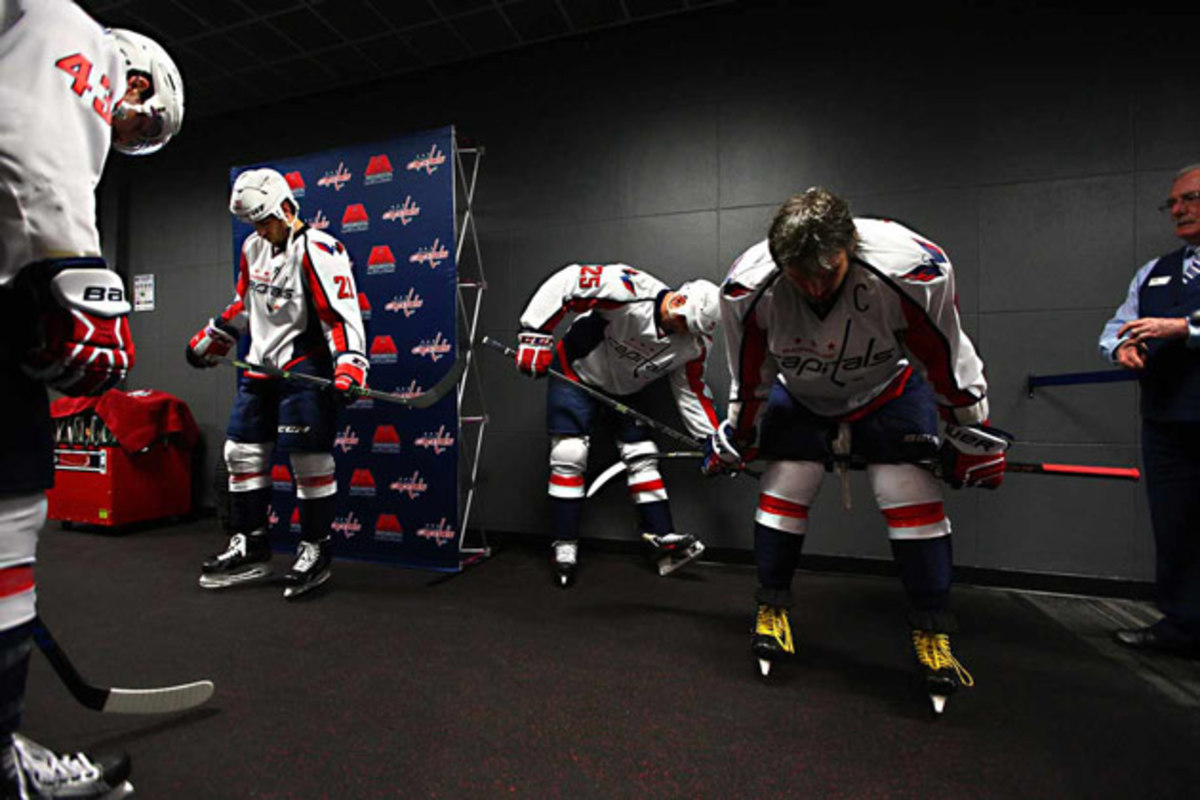
Like many coaches, Trotz never holds mandatory morning skates during back-to-backs, skipping the staple of the usual NHL game-day schedule to preserve energy. So players scattered when the meetings ended, seven hours before the puck dropped in Toronto. Laich hit the ice, looking for a few touches to keep his hands fresh. In the trainers’ room a Class 4 laser hovered over defenseman John Carlson’s left thigh, therapy for a purple bruise brought on by a blocked shot days ago. Oshie, with cords dangling by his sides, watched film on a laptop while his ARP machine helped circulate blood around four muscle groups. “Earlier in my career, I wasn’t really doing anything. I was just playing on energy and youthful excitement,” says the 29-year-old. “This is the next step for me.” A few players worked up a sweat by lifting weights. Others made time for a lengthy stretch. Down the hall, a queue formed for time on Brown’s massage table. In this, his first season with the team, Brown knew to expect more work during back-to-backs than on normal game days.
It was a drastically different scene from what their bosses remembered about NHL travel and training several decades ago—commercial flights the morning of the second game, rookies stuffed into middle seats. Sure, security was more relaxed, but “it’s not like they have meals for you after each game,” says GM Brian MacLellan, a former NHL winger who played with five teams during the 1980s and early ’90s.
Out in the narrow hallway Beagle pedaled a stationary bike and slugged from a bottle of coconut water. Among the more health-conscious Capitals, he laughed when recalling what passed for postgame recovery in the minor leagues, where two-in-twos and even three-in-threes are commonplace. “You ate what you could just to get something in your body,” he says. “Everyone puts money in a cup, orders food from one place.” Among the healthiest items were chicken Parmesan and Philly cheesesteaks.
NHL kangaroo courts fine for relieving players of their cash
Those issues are nonexistent in what Beagle calls “the Never Hungry League.” Between the final horn against Tampa Bay and takeoff to Toronto, he had already downed a protein shake heavy with glutamine, spent five minutes on the bike, bathed for six more in a cold tub and ate two full meals, both prepared by the team chef and approved by an in-house “nutritional task force.” At breakfast, defenseman Nate Schmidt took a vitamin supplement and remembered to eat a pear; a team-issued blood test had revealed he needed more vitamin B-12 and C in his diet. Everyone had their routines—Ovechkin, the goal-scoring cyborg, fueled himself with at least three cans of Coca‑Cola by game time—but whether the methods worked often depended on how the first night went. “Sometimes I feel better,” Beagle says, “and sometimes it’s a struggle on back-to-backs.”
For no one was this more true than goaltender Braden Holtby, a workhorse—through Sunday he had played in 39 of the Capitals’ 47 games—who also has a history of cramping. Last season Holtby led the league with 73 appearances, eight of which occurred on zero days’ rest. Though statistical wisdom suggested tapping a fresh backup is more prudent (this season, goalies who started both games are 30-27-11 on the second day), Holtby prided himself on maintaining an almost meditative focus in the crease that protected him from mental stress during back-to-backs.
But he also sheds around nine pounds of sweat per game. “Hydration’s the hardest part,” he says. So after learning on the flight that he would face Toronto too, he launched his recovery program into overdrive. He sipped salt-water throughout the afternoon and guzzled six small bottles of a pink electrolyte concoction upon coming to the rink for warmups. By the end of the night, after he made 32 saves and the Capitals completed their third back-to-back sweep of the season, Holtby had downed 17 liters of fluid. The average adult’s daily recommendation calls for three.
COMPLETE GALLERY: On the road with the Capitals
Washington Capitals Road Trip
Verizon Center, Washington DC
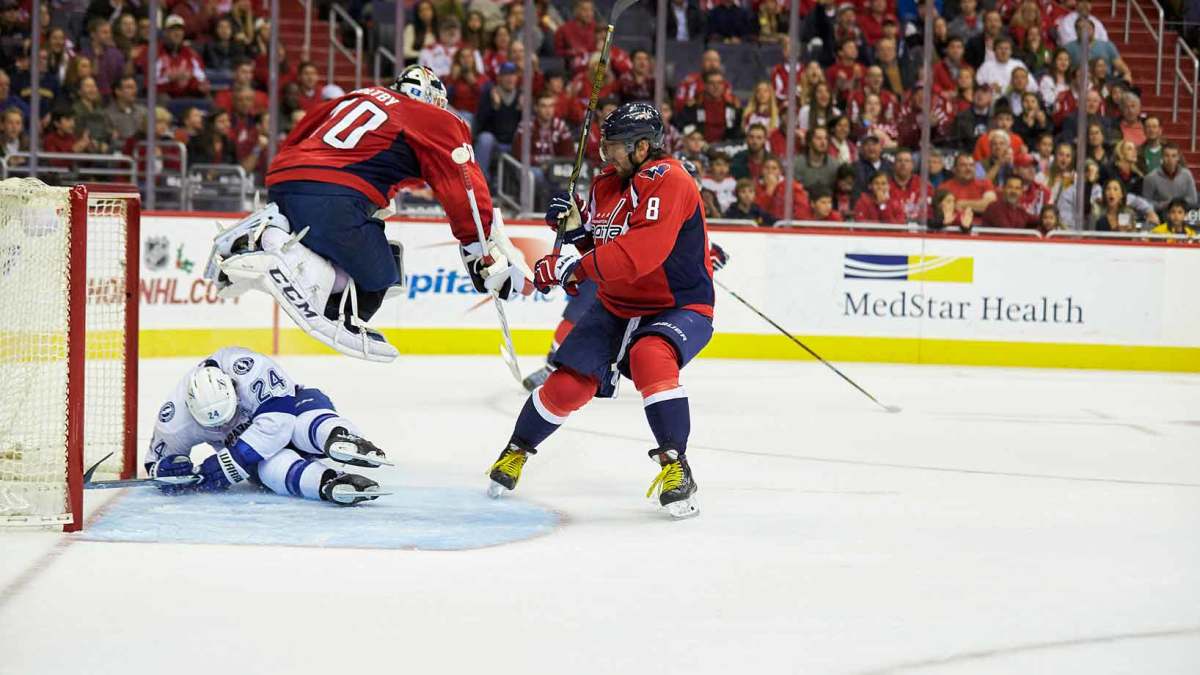
On Nov. 27, 2015 the final horn sounds at 7:46 p.m. as the Capitals beat the Tampa Lightning, 4-2, at home. Goalie Braden Holtby stopped 32 shots and Alex Ovechkin (right) scored his 12th goal of the season.
Verizon Center
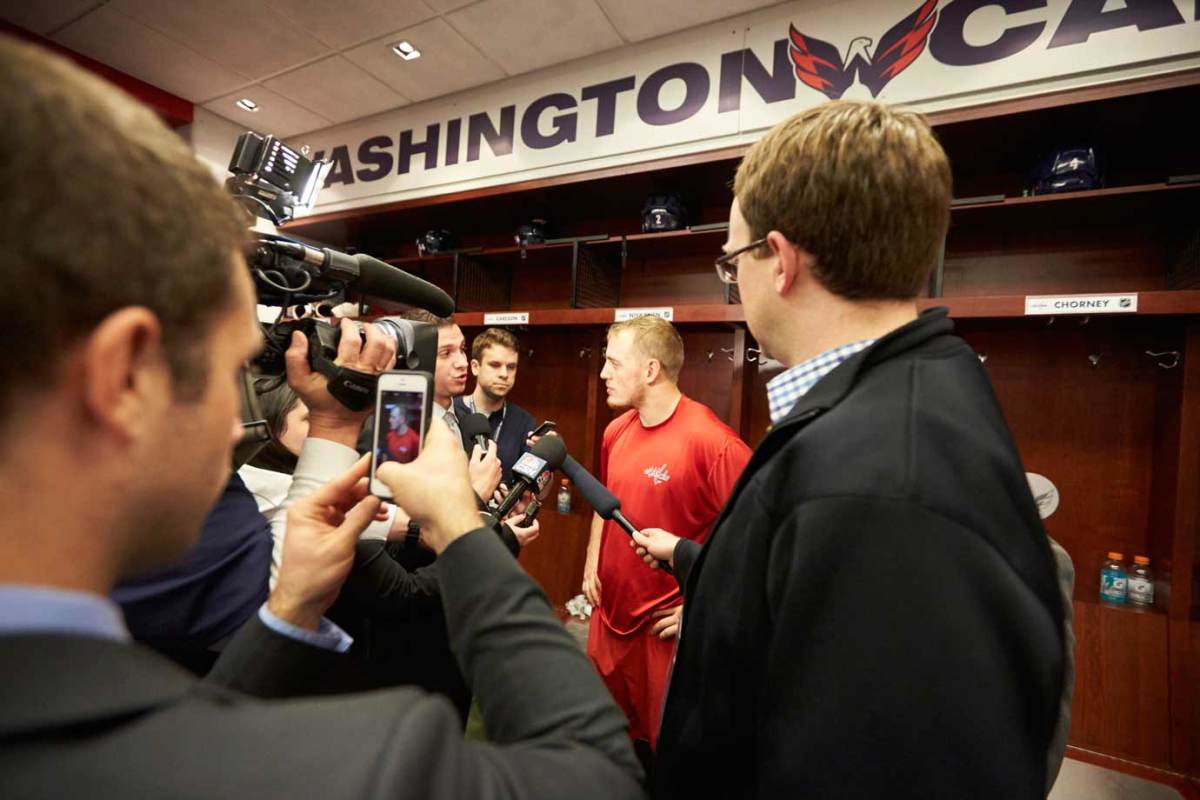
Defenseman Nate Schmidt conducts one of the hasty postgame interviews with the media. The Capitals have a 9:42 flight to catch at Dulles International and little time to spare.
Verizon Center
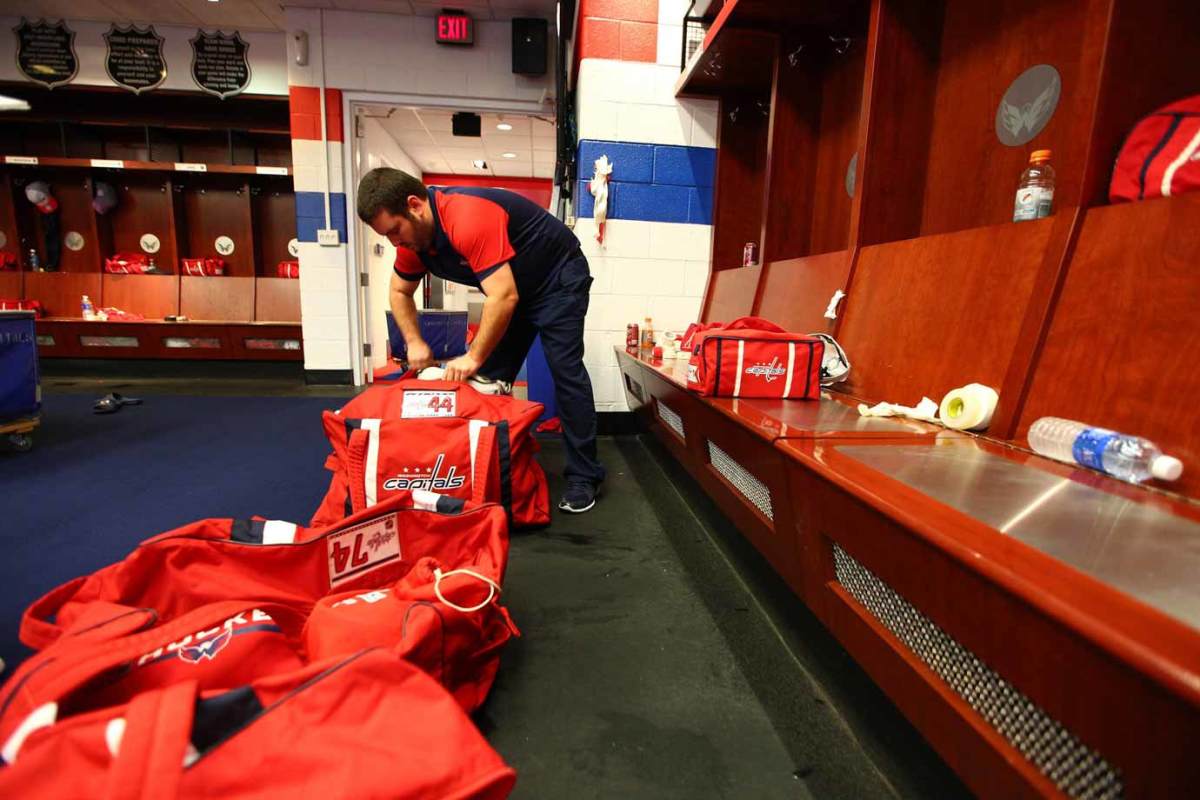
While the players dress and clear out, the Capitals equipment management staff swings into action, packing gear and fresh uniforms for the next night's game in Toronto.
Verizon Center
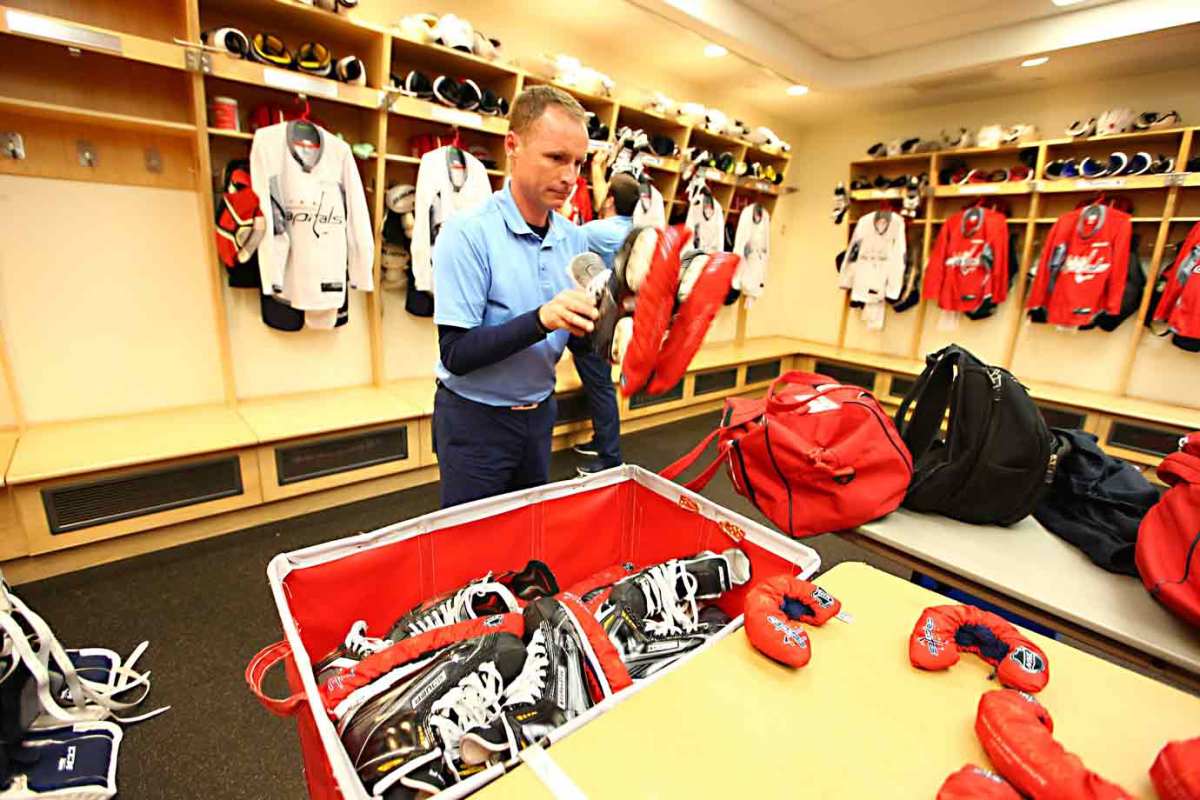
Equipment manager Brock Myles tends to the skates.
Verizon Center
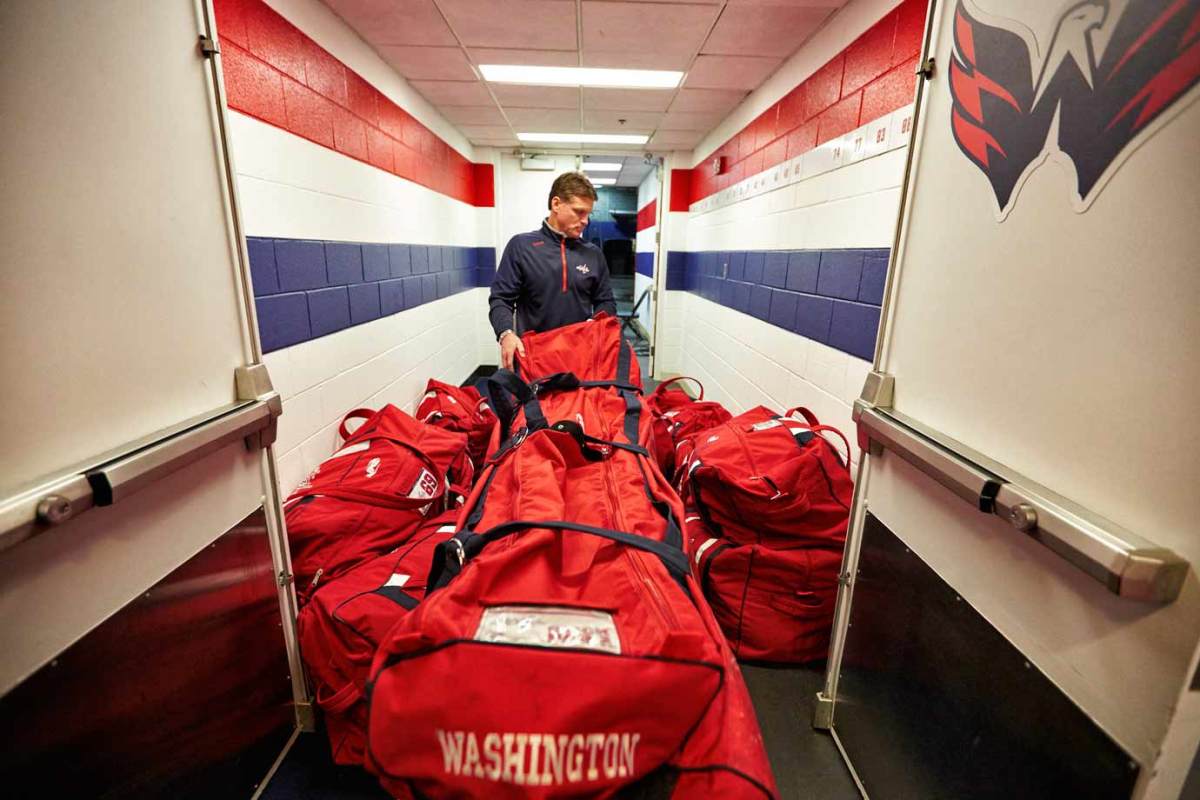
At 7:53 equipment manager Craig Leydig hauls the bags down the hall, out the arena's back exit and to a waiting box truck. In all, 2,770 pounds of gear will make the trip.
In the air
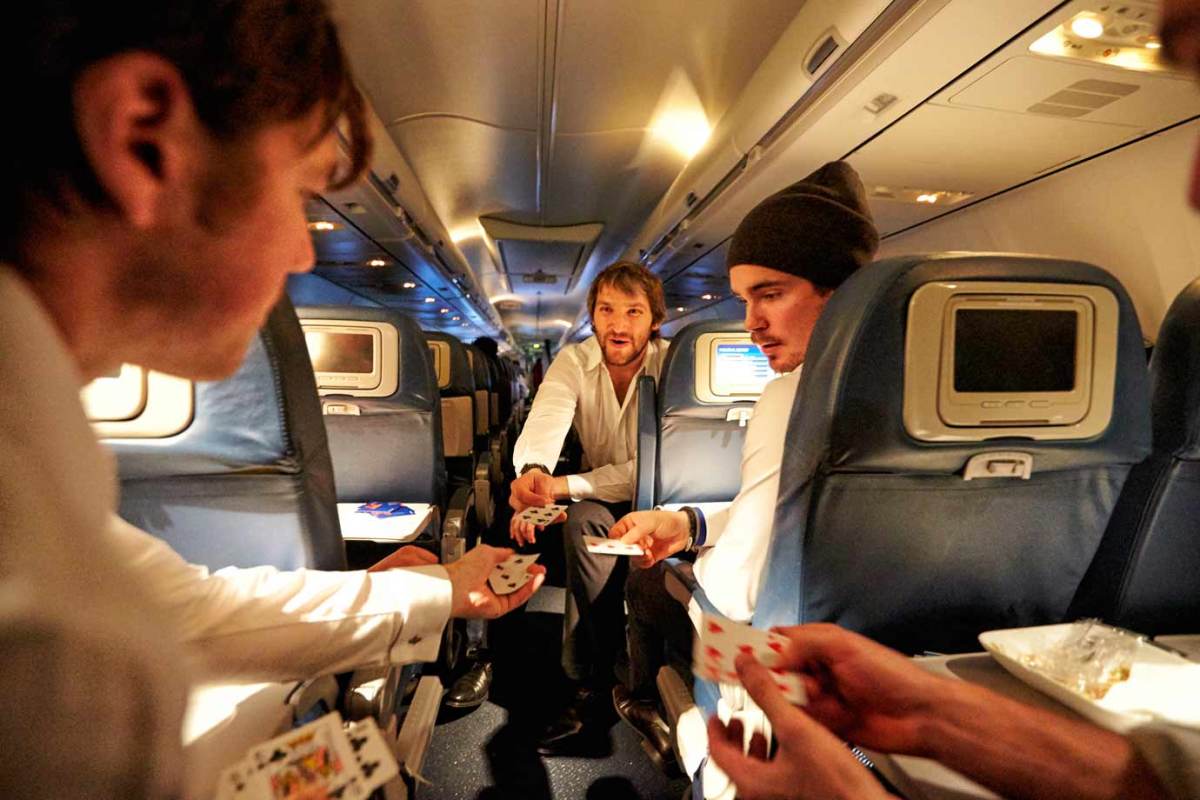
On their way to Toronto aboard a 737, Alex Ovechkin and teammates eat and relax with a game of 7 Up, 7 Down.
Toronto
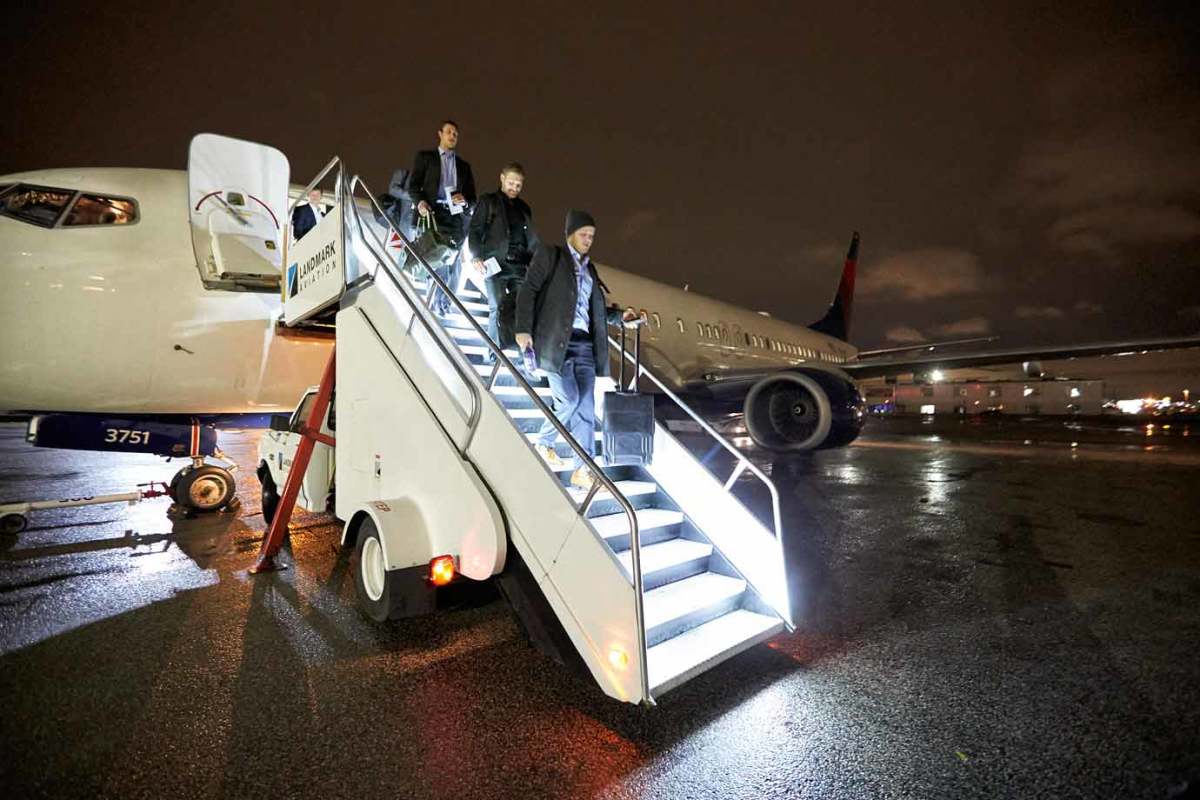
The Capitals touch down at Toronto Pearson at 10:30 p.m. and head for their accommodations at the Ritz-Carlton on Wellington Street West, one of the poshest hotels used by NHL teams.
Air Canada Centre
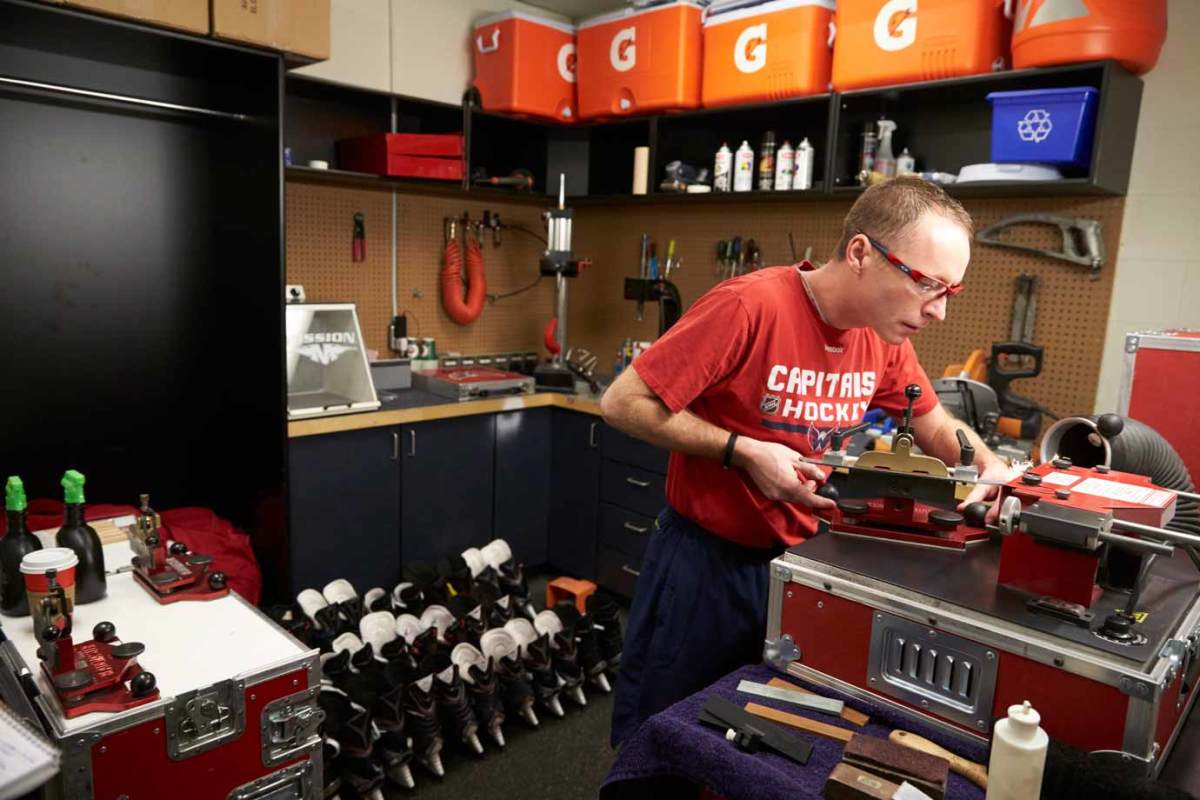
The staff gets to work bright and early the next day. By 7:49 a.m. equipment manager Brock Myles is sharpening skates.
Air Canada Centre
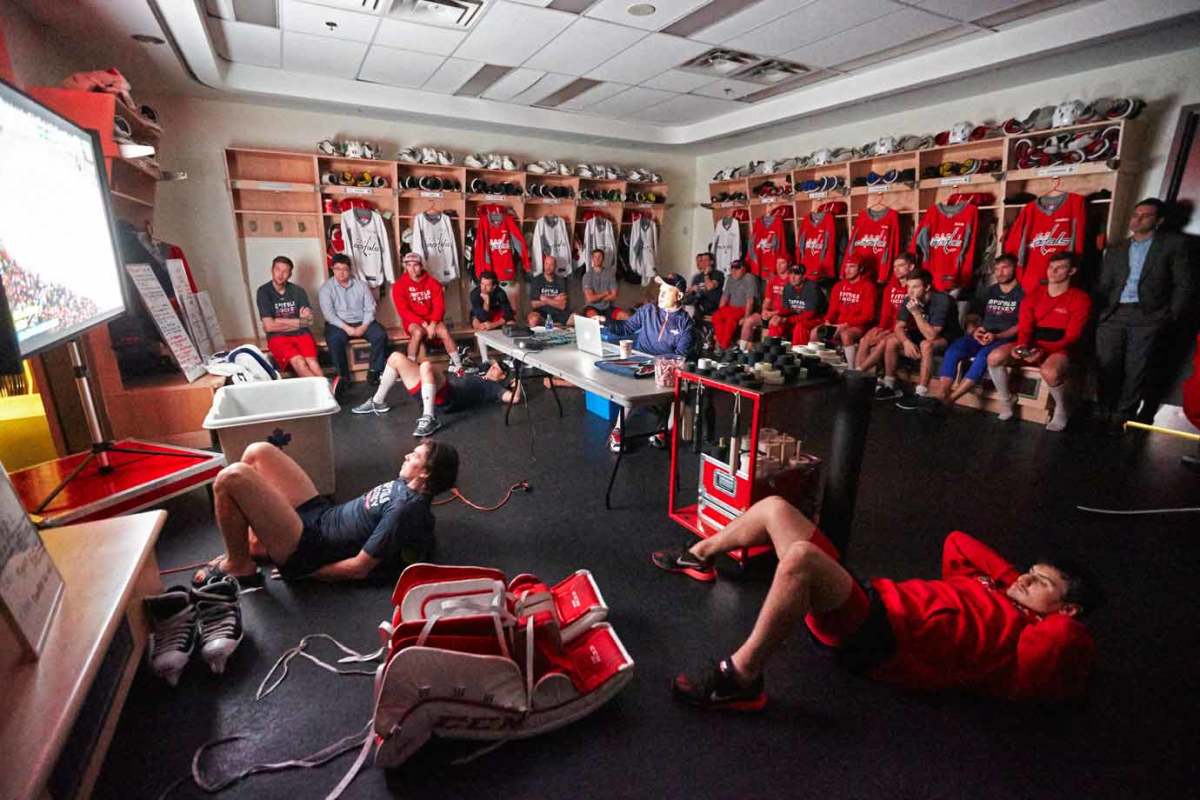
At 11 a.m. the Capitals gather with assistant coach Blaine Forsythe for their pregame scouting report on the Toronto Maple Leafs.
Riz-Carlton Hotel
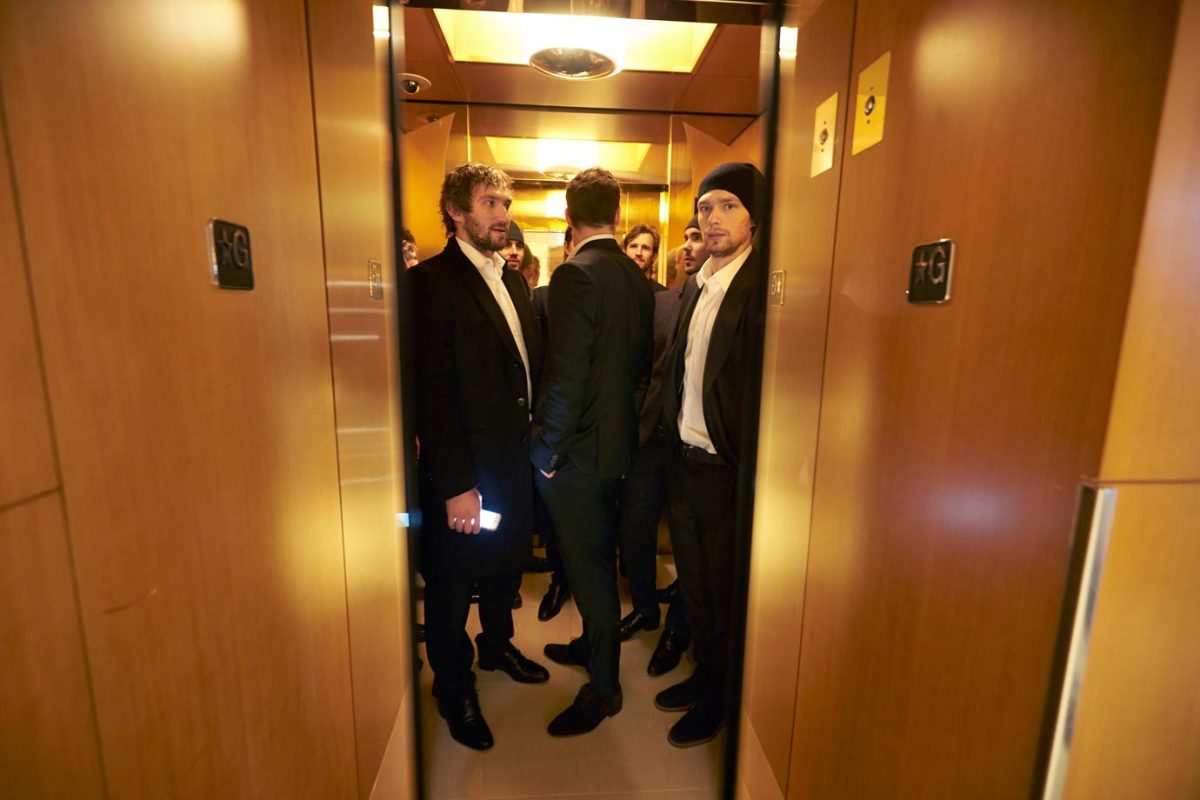
After their morning meetings, the Capitals return to their hotel for a meal and afternoon nap.
Air Canada Centre
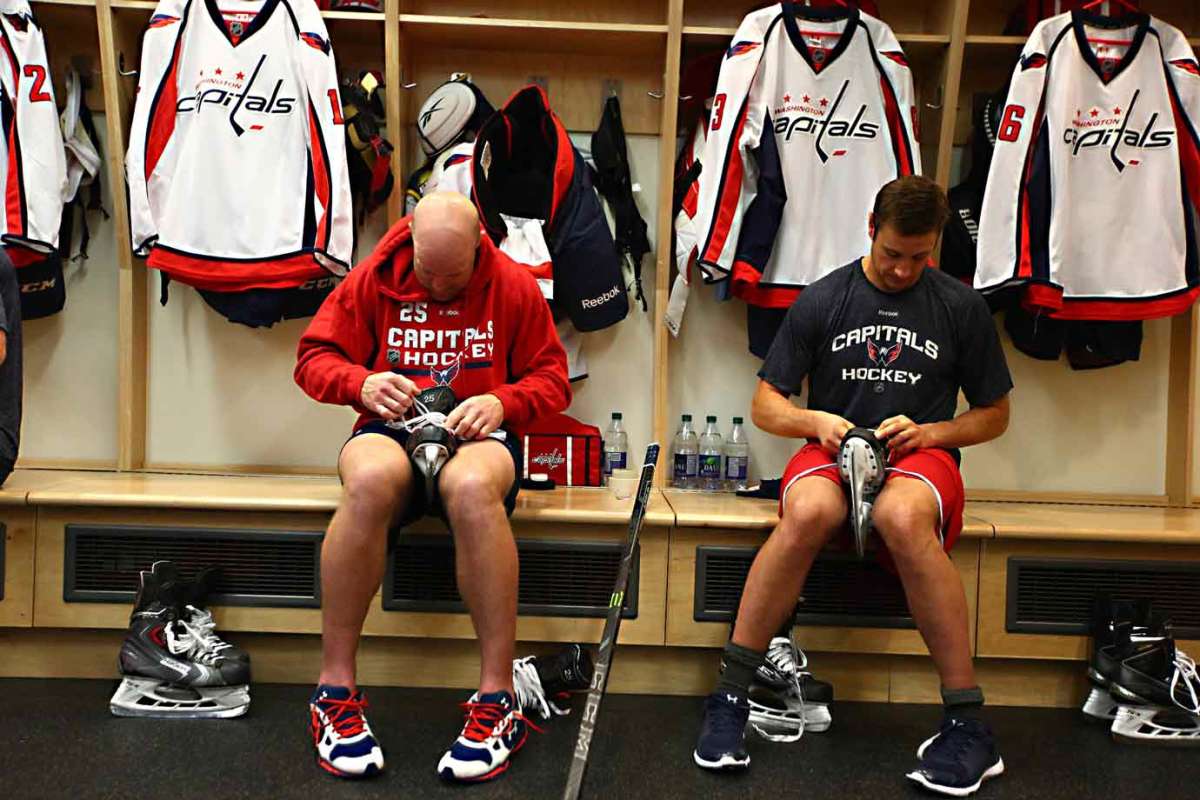
By 6 p.m. Jay Beagle and Tom Wilson are gearing up for the night's action.
Air Canada Centre
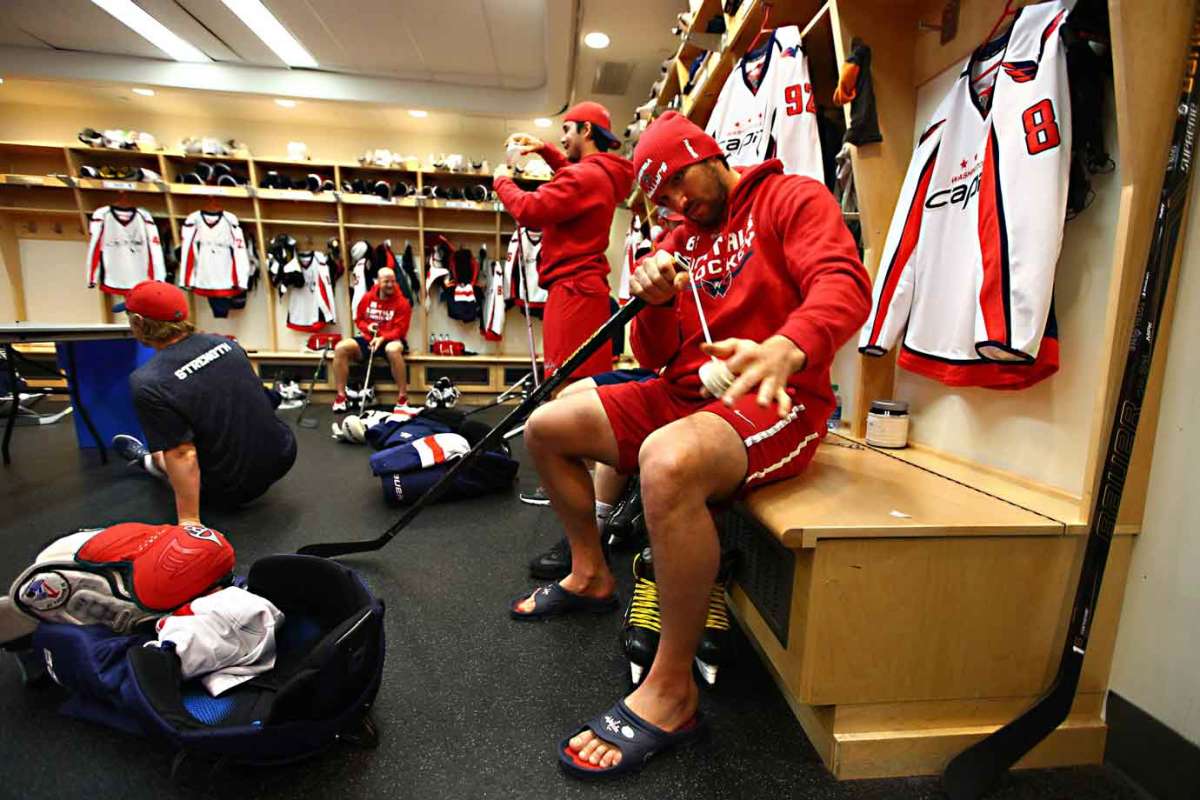
Captain Alex Ovechkin tapes a stick.
Air Canada Centre
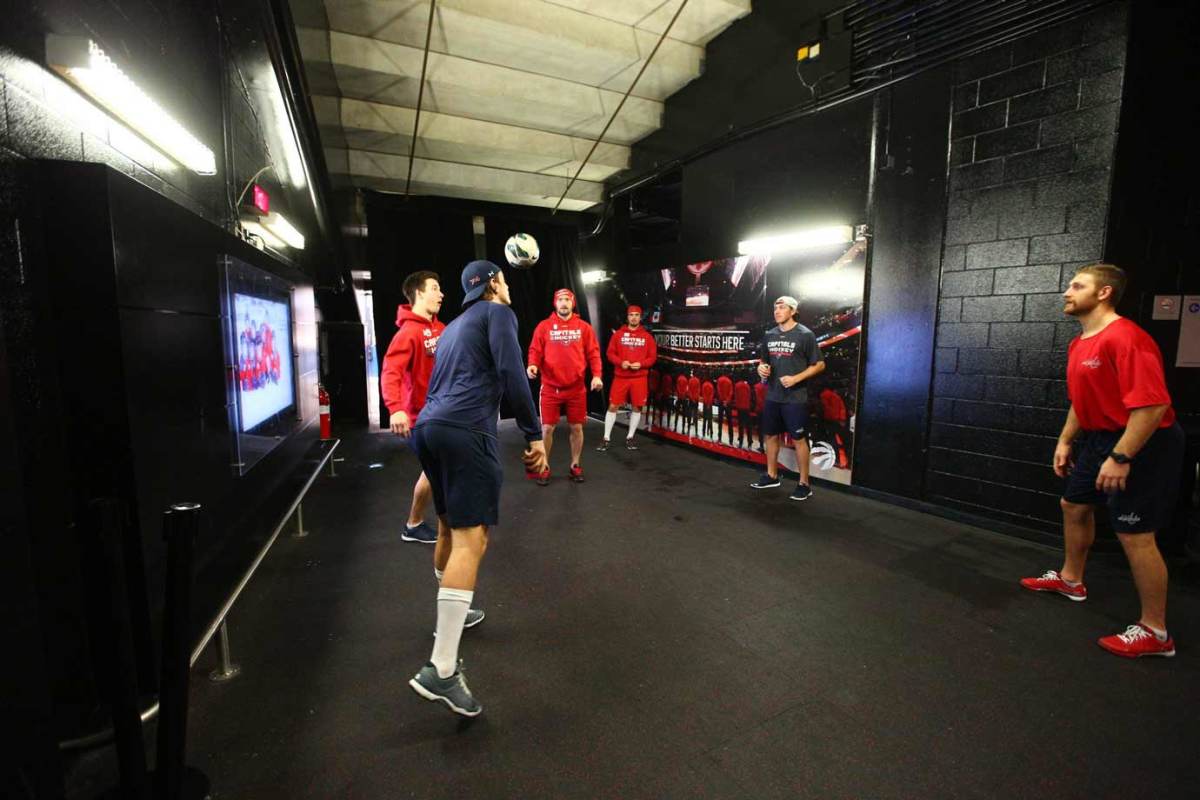
Some of the Caps warm up in the hallway outside their locker room by kicking a soccer ball around.
Air Canada Center
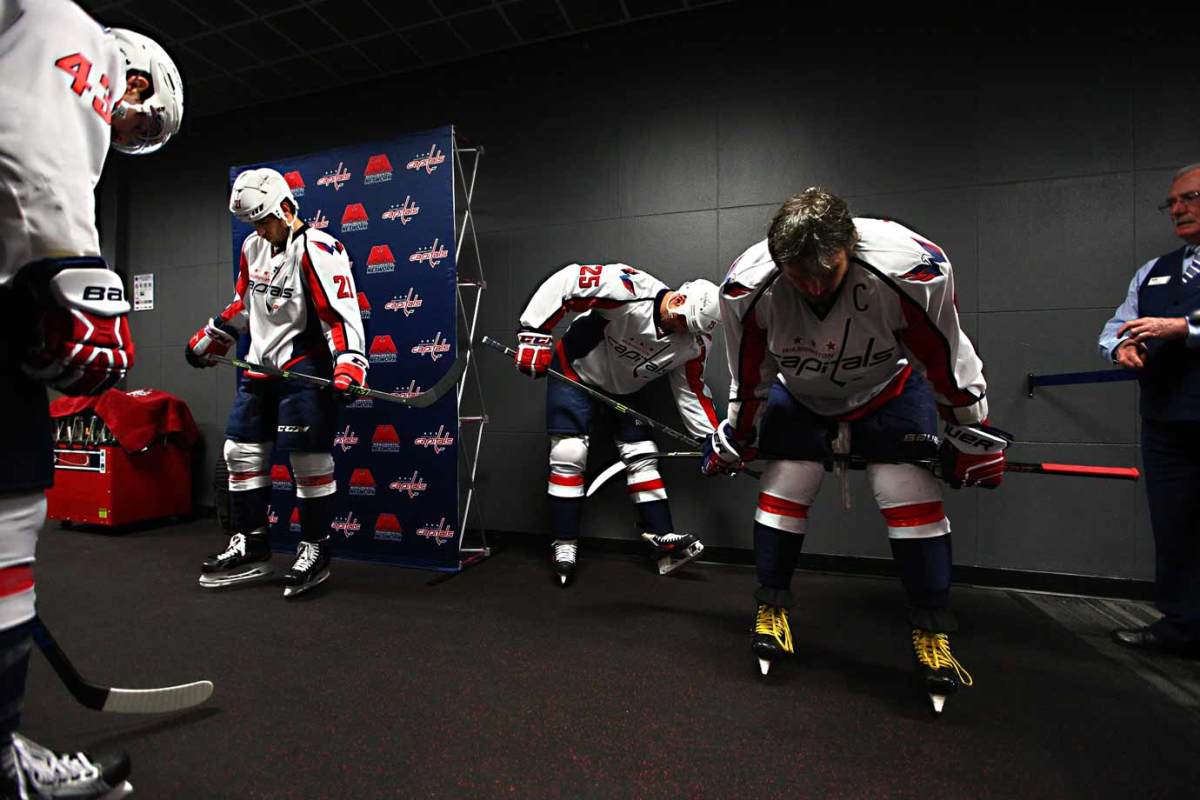
Fully dressed for battle, the Capitals prepare to take the ice for warmups.
Braden Holtby
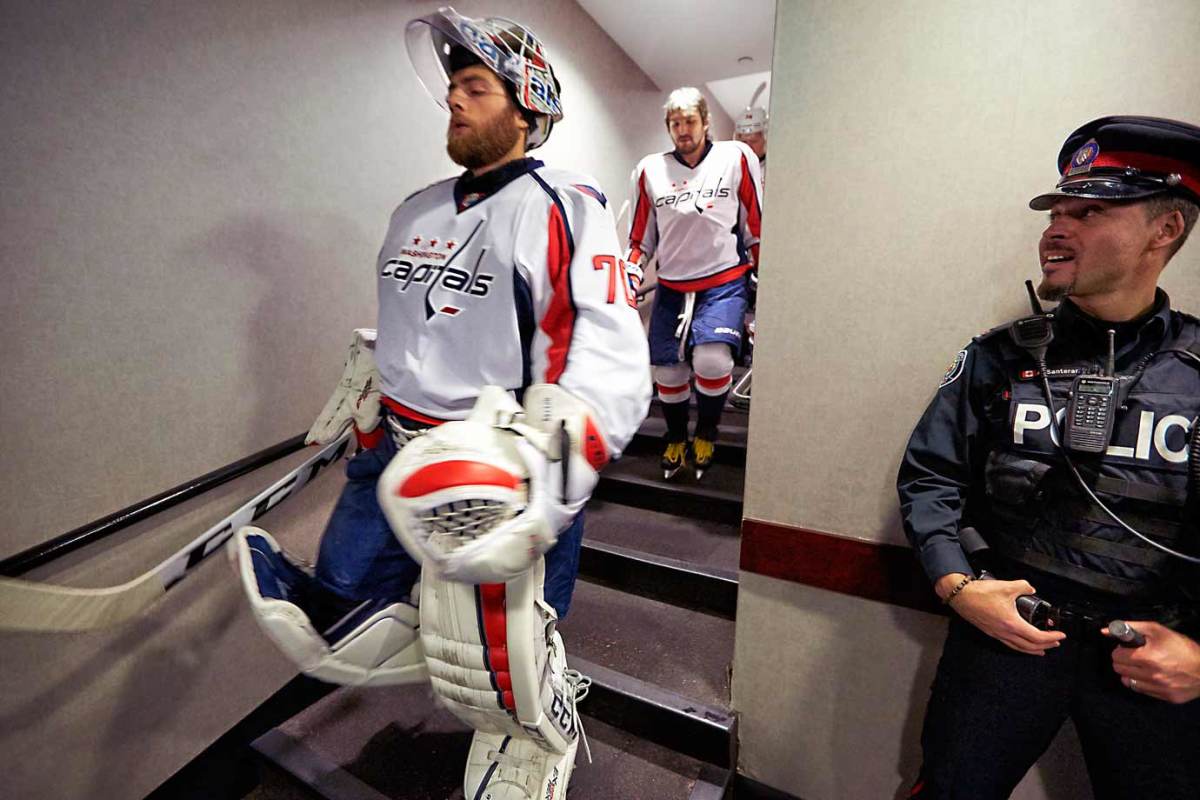
At 6:35 p.m. the Caps' star netminder leads the team out for its pregame skate.
Justin Williams
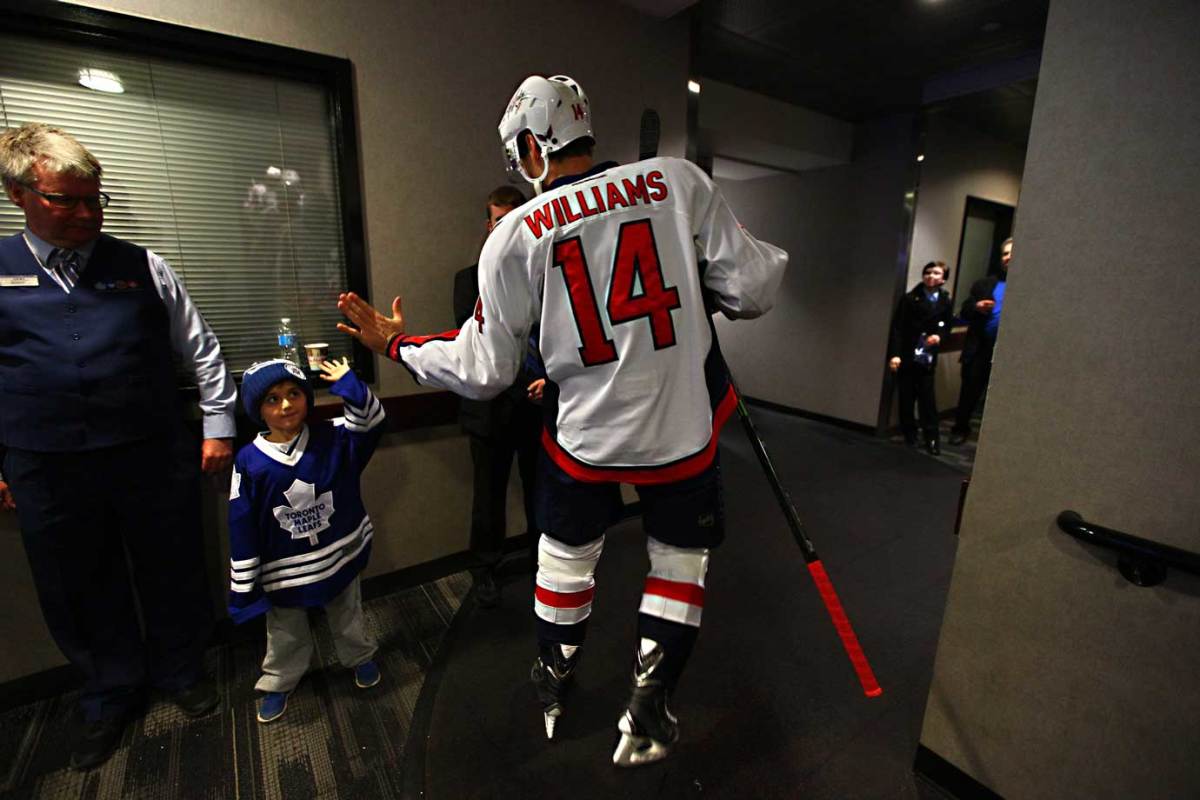
On his way out to the ice, the Capitals' veteran forward greets an enemy fan.
Air Canada Centre
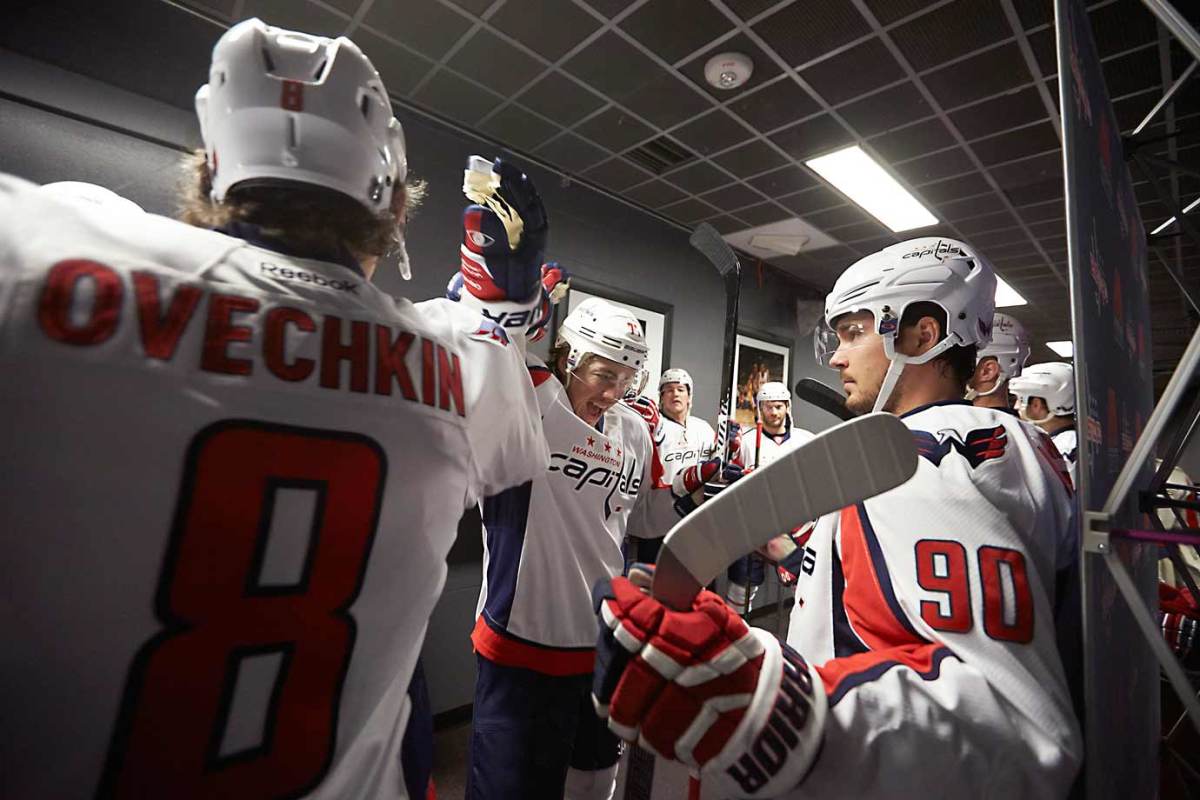
Having done their best to shake off the effects of the previous night's game and prepare for the next tilt, the Capitals share a moment before taking the ice against the Maple Leafs.
Air Canada Centre
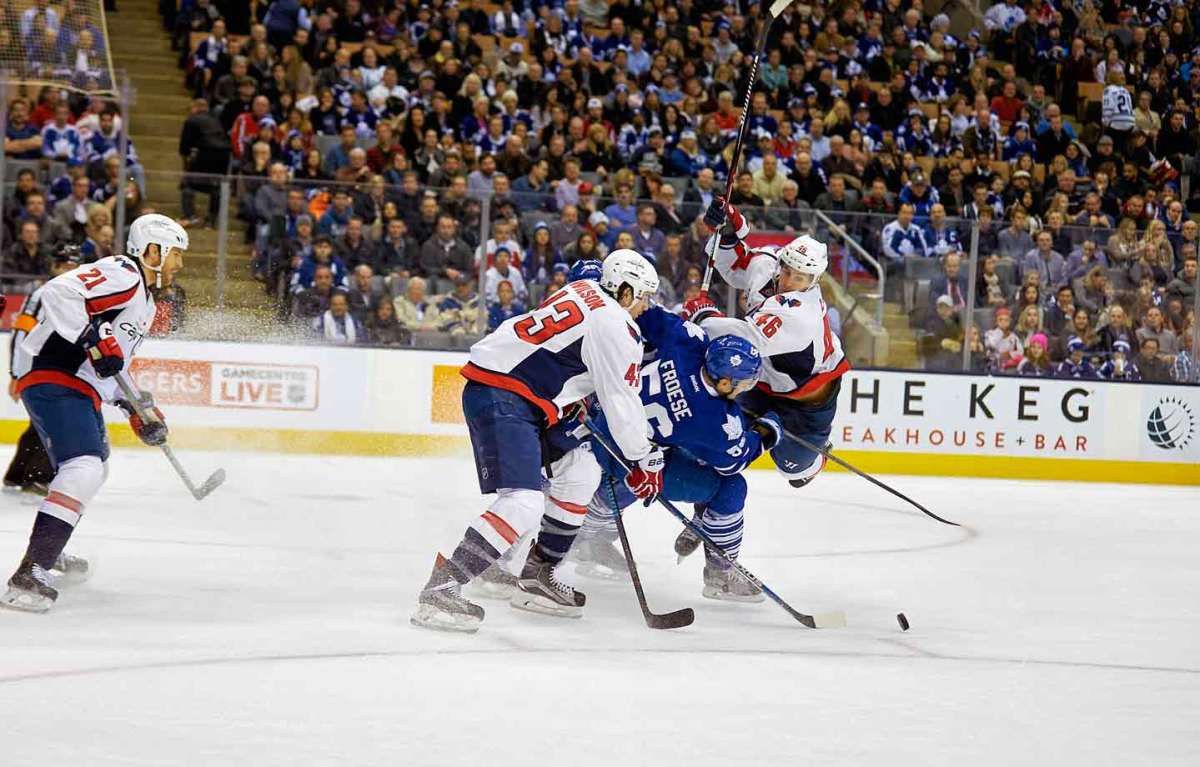
The Capitals survive a sluggish first period, cash in a pair of power plays in the second, and go on to a 4-2 win over the Maple Leafs.
Air Canada Centre
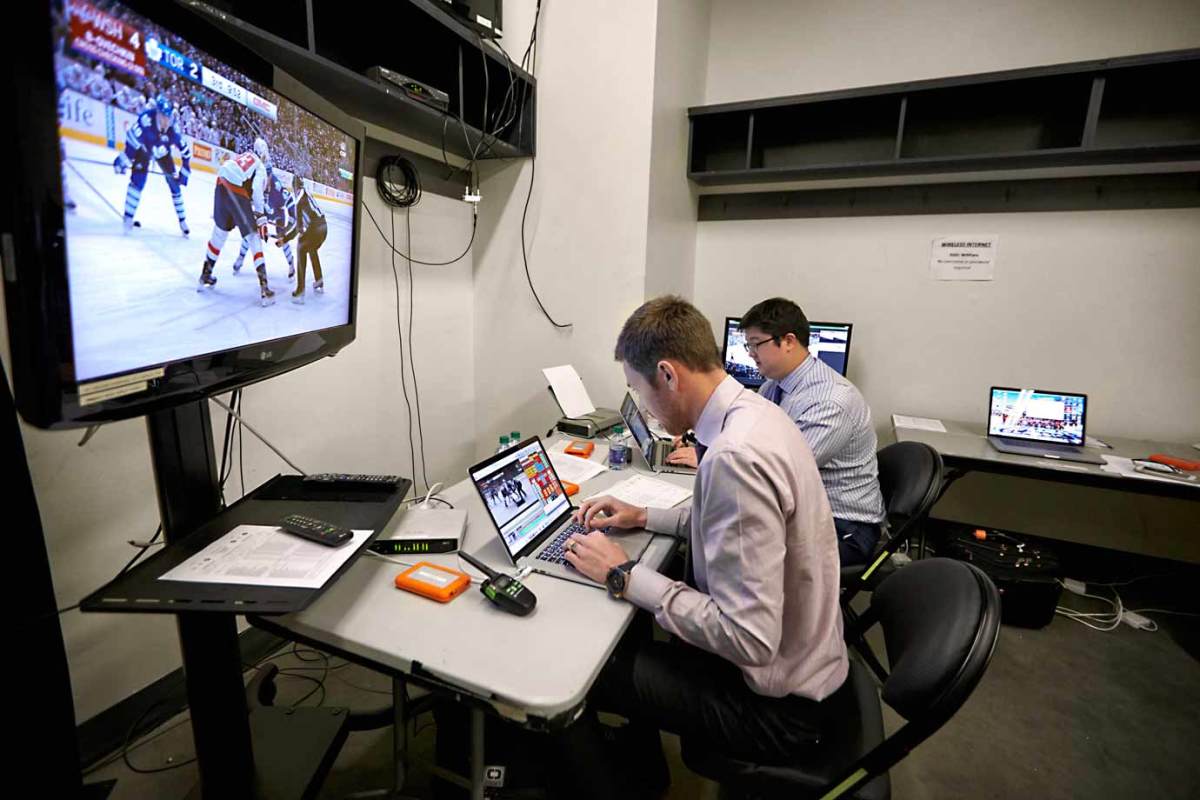
At 9:27 p.m., while the Caps do battle on the ice, members of their coaching staff analyze the action in real time.
Air Canada Centra
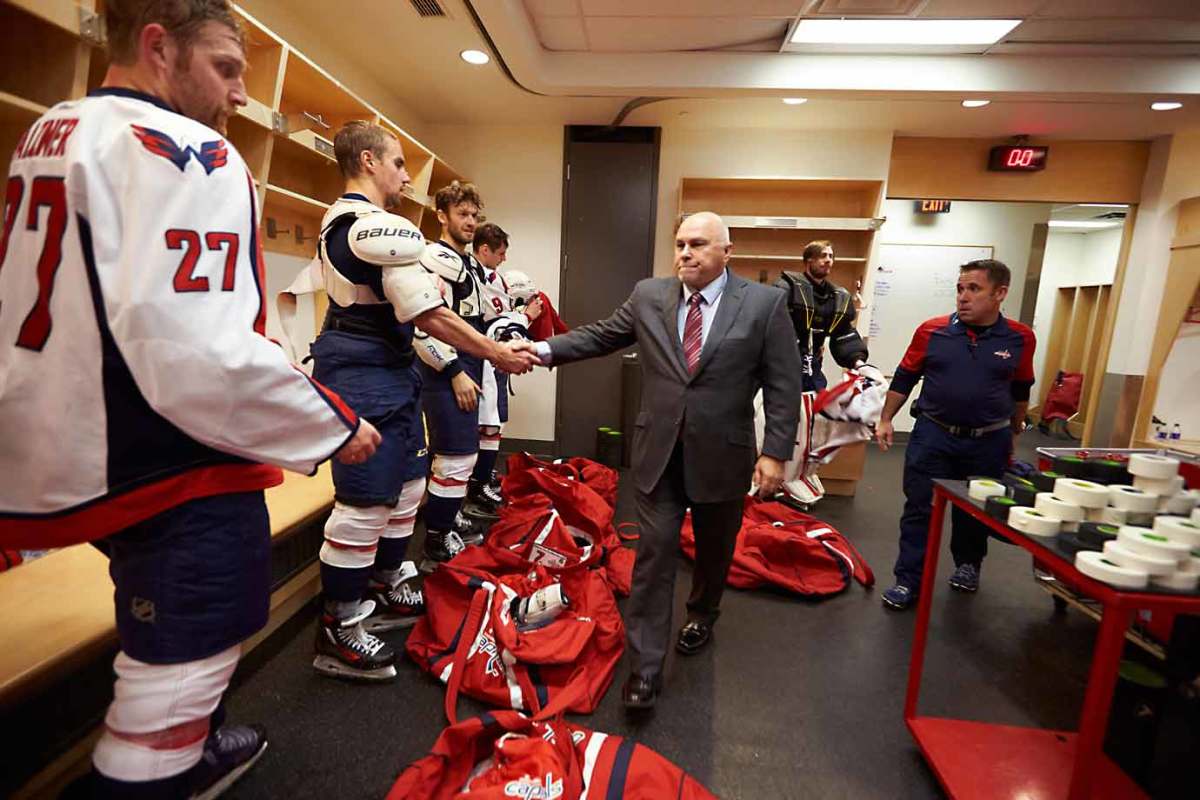
Coach Barry Trotz congratulates his troops after their victory.
Air Canada Centre
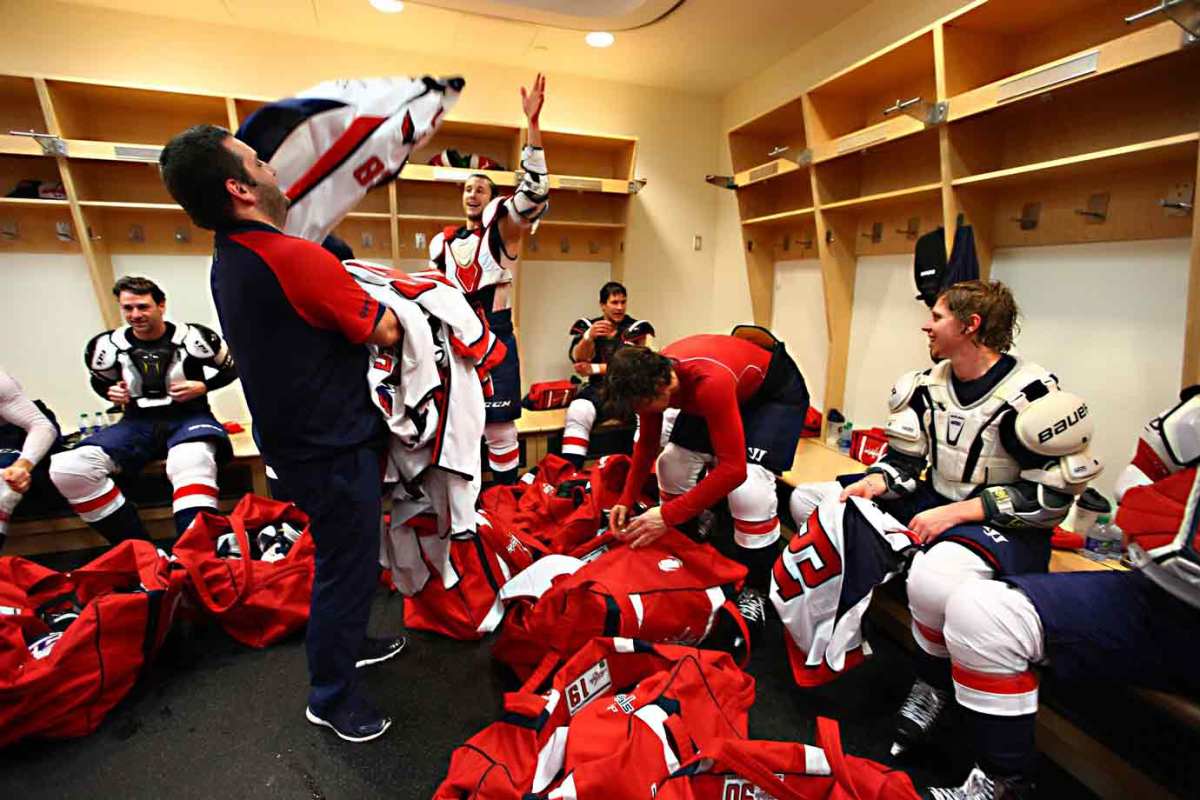
The victors unwrap and get ready to go.
Air Canada Centre
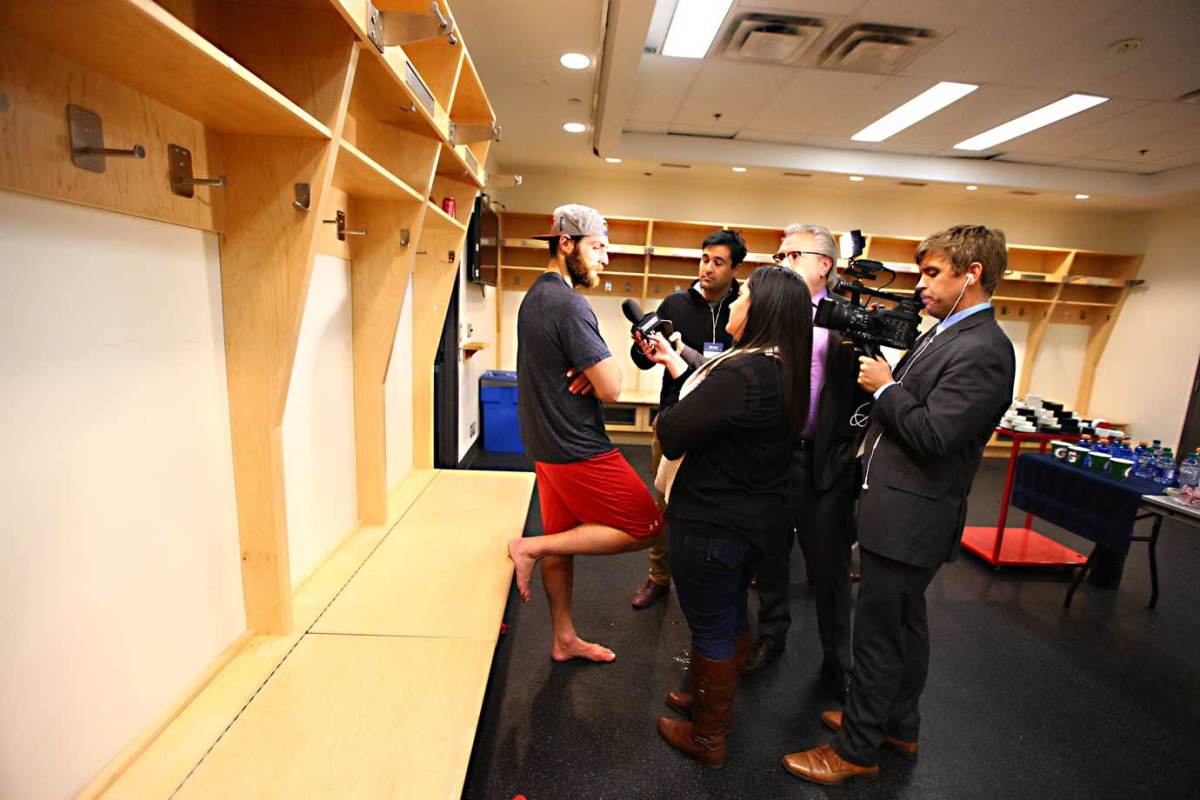
Goalie Braden Holtby conducts one of the final interviews with the media. By 9:58 p.m., the visitors' locker room will be a ghost town as the Capitals head to the airport for their flight back to Washington.
Justin Williams
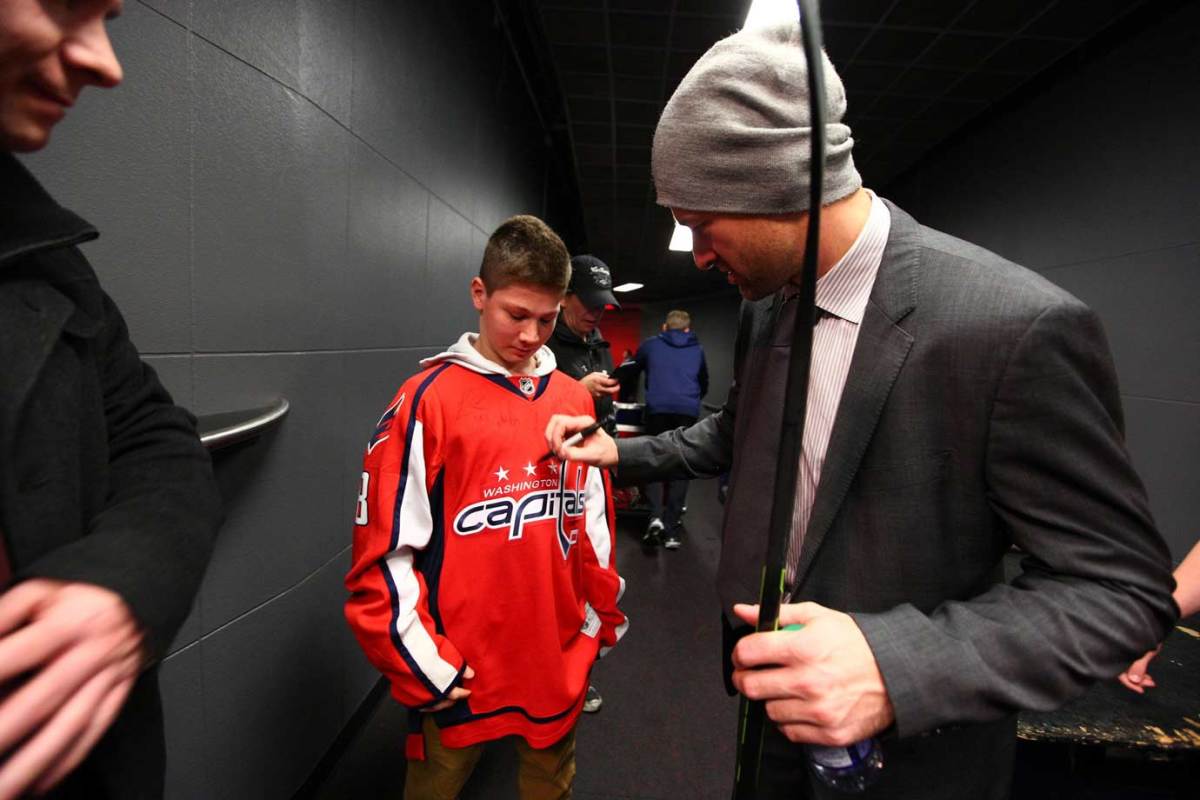
Time for a quick autograph before heading for the airport.
Toronto Pearson
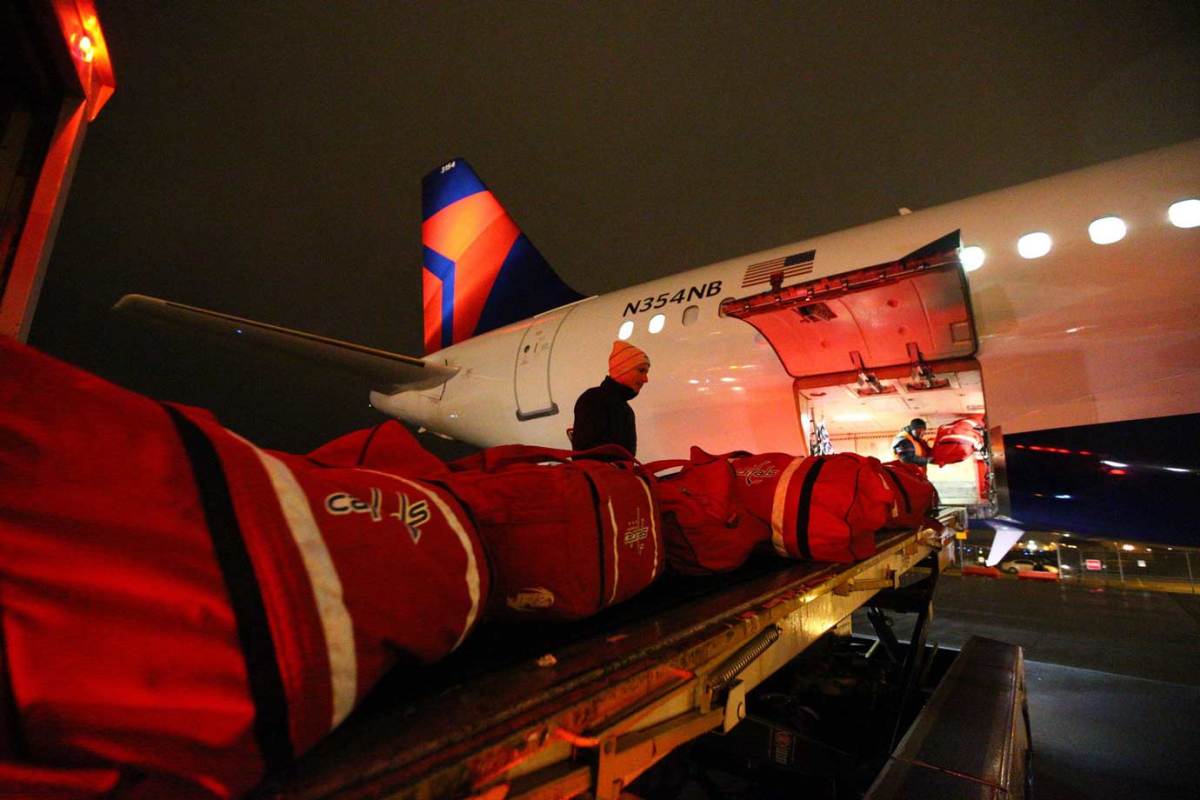
Back on the plane goes the gear. Their flight delayed, the Capitals would not take off until just after midnight.
Dulles International
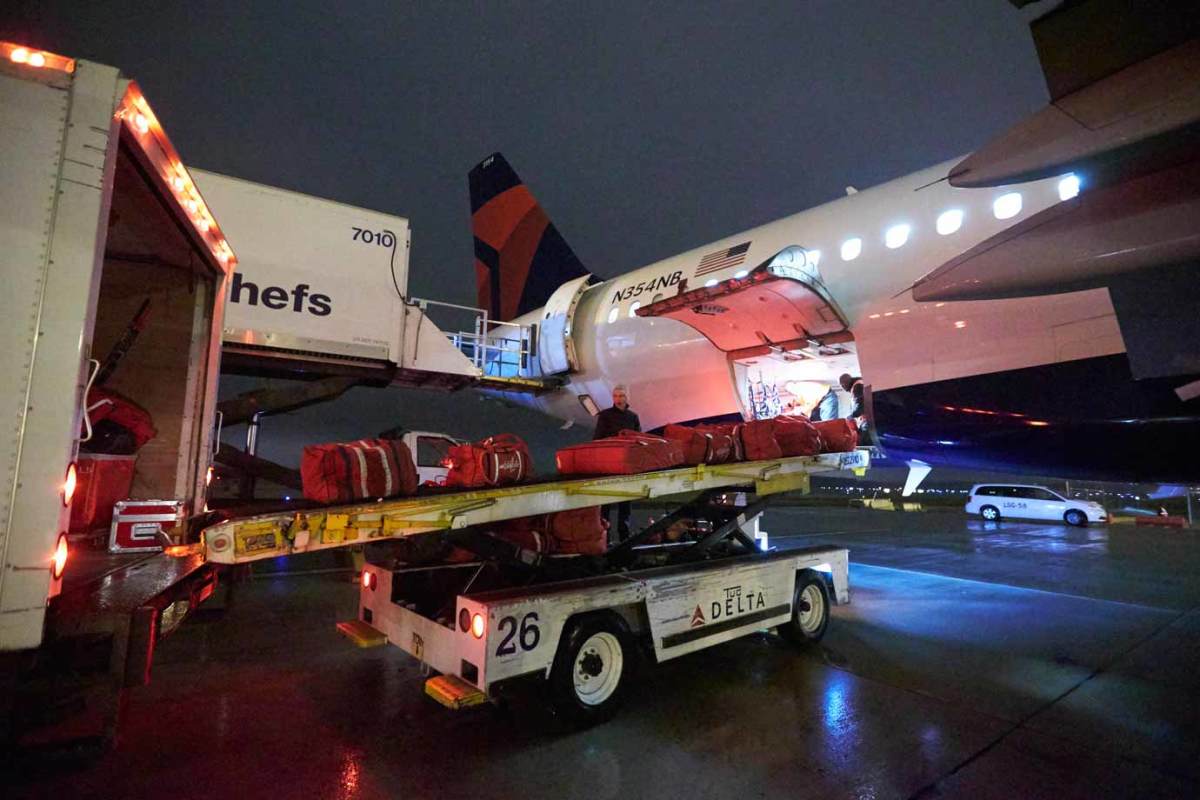
Home sweet home. The gear is unloaded at 1:21 a.m. in DC.
The Capitals lurched through the first period against Toronto, outshot 16–4. A particularly lethargic start, it was reminiscent of their struggles last season. Still, one of their four shots—a wrister from Jason Chimera on a two-on-one break—hit the net, and they entered intermission tied. Two unanswered power-play goals in the second boosted Washington to a 4–2 win, the team’s fifth straight. And though they had just played 120 minutes of hockey in 29 hours, the Capitals came off the ice full of energy.
But by 9:58 p.m. the visitors’ dressing room was a ghost town. All 2,770 pounds of baggage had been loaded back onto the equipment truck, which rolled out at 10:51, followed by the two team buses. Since returning Stateside meant going through commercial customs, a hassle with such a large party, the sign outside their gate at Toronto Pearson read, delayed. Under different circumstances this might have mattered. But the Capitals had an off-day scheduled for the next morning. Taking off just after midnight was no big deal for the players.
As flight attendants passed around roasted chicken and broccoli, equipment managers Brock Myles and Craig Leydig quickly fell asleep, taking advantage of a few minutes without responsibilities. That night they would not clock out until 3 a.m., leaving the practice facility only after the bags had been unpacked, the laundry shoved into the industrial washer and the stalls arranged and doused in antiodor spray.
Upon landing at Dulles, the players hopped into their cars and drove home. But below the plane Myles and Leydig, for the fourth time in 29 hours, began yanking bags off the conveyor belt. A light drizzle patted the ground. They looked tired. “Back-to-back,” Myles said, explanation enough.
